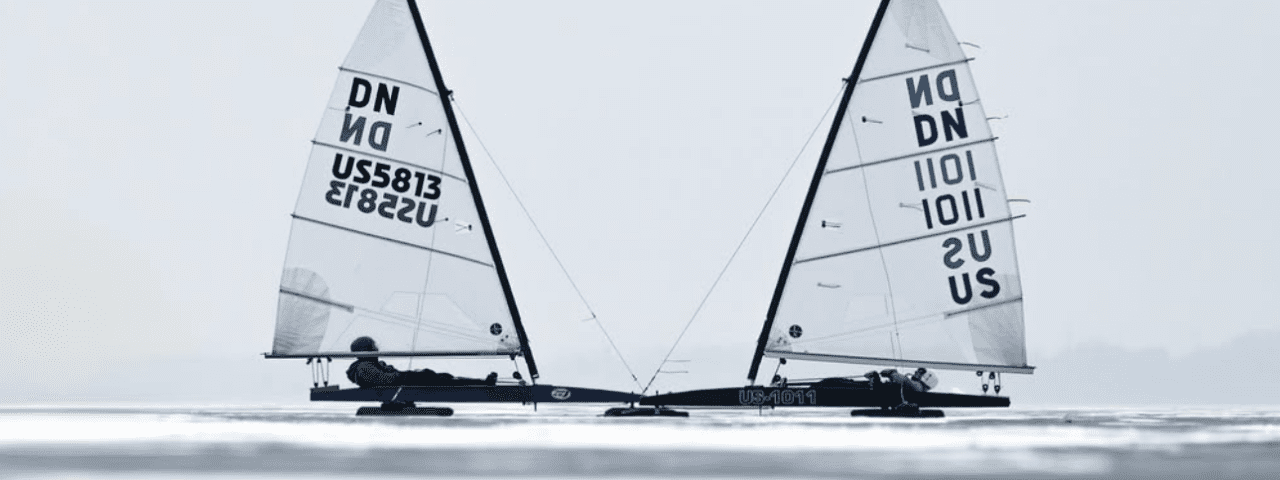For thrill-seekers and winter enthusiasts, ice boating offers an adrenaline-pumping experience unlike any other. Imagine lying flat on your back, feet-first in an open cockpit, as you race across frozen lakes at breathtaking speeds. With boats capable of traveling up to four times the speed of the wind, ice boating promises an intoxicating blend of speed, danger, and excitement. It’s a sport that challenges the adventurous spirit, rewards precision and patience, and delivers an unforgettable experience for anyone who loves the sport of sailing.
What is Ice Boating?
Ice boating has been around since the late 1930s, with the DN class emerging as the most popular. These boats are marvels of simplicity and creativity, featuring three skates (or blades), a control line, and a tiller for steering. This straightforward design has inspired countless enthusiasts to innovate, tweaking their setups to gain even the smallest speed advantage. The result is a sport where craftsmanship and performance go hand-in-hand.
Ice boating requires smooth, sturdy ice—a rare and fleeting condition that draws speed chasers from all over the country. It’s not just a race against competitors but a race against time, as conditions change constantly and rapidly. These boats race across the frozen water, reaching up to 100 kph (62 mph) or even the record-breaking speed of 140 kph (86 mph). The blend of a narrow window of opportunity combined with the exhilarating thrill of racing across the ice is an irresistible challenge to sailors.
Building and Customizing Boats
For many enthusiasts, ice boating isn’t just about racing; it’s about building and refining their boats. Described as “adult Legos,” these boats can be assembled with basic tools and epoxy. Choosing the right blades is another key consideration for sailors, with different blade lengths and shapes tailored to varying wind conditions. Akin to which type of ski you choose based on snow conditions, blades vary in length and shape, and an ice boater must choose blades that will optimize boat speed based on the wind and ice conditions that day.
“I’d never built more than a birdhouse as a kid,” admits Samuel Bartel, the Junior Director for the DN class North American division. “But I just thought it would be kind of fun to try building.” This hands-on aspect of the sport fosters creativity and offers a deep sense of accomplishment for those who take on the challenge.
Safety First: Preparing for the Ice
Despite its risks, ice boating prioritizes safety through meticulous preparation. Before setting sail, participants scout the ice daily, using long drill bits to check thickness and identify hazards. The ideal ice is 4 to 7 inches thick, with a few hundred yards of smooth, crack-free surface marked as a safe boundary for racing.
“Safety is definitely a major priority,” says Bartel, who’s passionate about introducing kids to the sport. Beginners, for example, are typically kept off the ice during windier days to reduce the risk of accidents.
On the variable conditions, Bartel says “it’s just part of the sport… it can be a bit fickle,” but he notes his belief that people are discouraged from attempting ice boating due to the emphasis on danger and remaining unaware of the detailed level of safety precautions taken before any session.
“It may seem scary on the outside, but it’s not all that different from skiing.”.
By combining rigorous checks with clear safety protocols, the sport balances its high-speed thrills with responsible practices.
Why Try Ice Boating?
Ice boating offers more than just speed—it’s a chance to connect with nature, extend your sailing season, and explore new places. Unlike summer sailing, where conditions are more predictable, ice boating often requires travel to find the perfect surface. Enthusiasts might drive 3 to 8 hours regularly with their boats in tow, chasing the elusive thrill of perfect ice.
“It’s one of the best things you can do in winter,” says Bartel. “A great way to get outside and learn more about sailing and extend your season.”
A Gateway for Young Sailors
Getting kids involved in ice boating is a key focus for Bartel. With about 75 young sailors in Minneapolis and another 25 across Wisconsin and Illinois, the sport’s youth community is continuously growing. The age range for participants typically spans from 7 years old to college age, with most falling between 10 and 17.
To encourage participation, organizers use email lists, text groups, and Facebook pages to connect with potential sailors and share condition information.
Begin your Ice Boating Adventure
For those curious about trying ice boating, the first step is connecting with the community. Facebook groups and the DN class webpage are excellent resources for learning about the sport, finding events, and meeting experienced sailors. Whether you’re a seasoned sailor or completely new to the sport, ice boating offers an exhilarating way to embrace winter and make the most of frozen lakes.
So, bundle up, gear up, and take the leap into ice boating. The frozen horizon awaits—and with it, the adventure of a lifetime.
If you are an ice boater and don’t see your class represented in One Design Central, please put us in contact with your class representative. We want to celebrate your class and the sailors participating in it!


